 |
|
 |
|
The following article can be found on the Natural Horse website at www.NaturalHorse.com (Volume 4, Issue 6, Article 10).
TMJ and TMD
|
||||||||||||||||||||||||||||||||
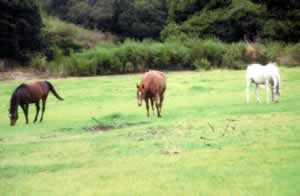 |
| During grazing the mandible is allowed to slide down and forward, and the atlantoaxial joint can open. This relaxes TMJ muscles and allows for proper teeth contact. |
Horses rely on the proper function of the temporomandibular joint mechanism, or TMJ Mechanism, just like we do, if not more! The ability to move the jaw properly - side to side, up and down, forward and back - affects not only the ability to chew and digest food, but also affects the body’s balance and biomechanics. Proper function of the TMJ Mechanism is vital to horse health.
Today, all horses are exposed to a variety of contributing factors that affect the proper movement of the jaw. Some of these factors include the wearing of certain types of bits or nosebands, eating out of hayracks, getting stuck between fence posts, undergoing various types of dental work, and lack of proper dental work. Due to these and other factors, horses are prone to the condition known as Temporomandibular Dysfunction, or TMD.
TMJ is the abbreviation for temporomandibular joint. Anatomically, it refers to an area of the cranium where the jaw, or the mandible, contacts and articulates with the temporal bone. The temporal bone is the area of the skull where the ear resides. When these bones are misaligned and not articulating properly and the surrounding tissue of the TMJ is stressed, the TMJ Mechanism is out of balance and cannot function optimally. This condition is known as Temporomandibular Dysfunction, or TMD.
The term TMD is used in the field of dentistry as a diagnosis for people who experience tightness or dysfunction of the TMJ mechanism or jaw. TMD affects overall health. Indicators of a TMD condition include popping and clicking in the joint area, headaches, bite misalignment, and gritting of the teeth. If the condition is left untreated, the cartilage that makes up the articular disc that allows the mandible to move will be worn down and damaged. In severe cases of TMD, the precious cartilage is completely worn away.
The condition known as TMD occurs in all horses regardless of discipline. Horses exhibit signs of possible TMD discomfort in several different ways. TMD goes hand-in-hand with the misalignment of the upper and lower incisors and/ or any imbalances that may appear in the wear of the teeth, such as hooks or waves, and each perpetuates the other.
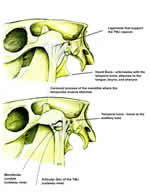 |
| Click here to view a larger image (43 Kb) |
Different Signs of TMD and Imbalances in the TMJ Mechanism
TMD shows up in many different shapes and sizes and cases differ in levels of severity. Horses with TMD will clearly show low levels of performance, improper gaits, uneven wear of the teeth, possible head shaking, signs of headaches, cribbing and/or various behavior problems. In some cases, even a slight retrusion in the lower jaw can be seen - the lower incisors of the mandible come behind the upper incisors of the maxilla. Any horse that has TMD will have some level of difficulty in performance.
A way to check to see if your horse has any form of TMD is to look at how your horse’s incisors align. The upper six incisors should align with the lower set, directly in the middle. If you see a pull to one side or the other, it is likely that your horse has some discomfort with its TMJ Mechanism. Even though the teeth may align, the muscles that make up the TMJ may still be tight, causing discomfort.
Other indicators of possible TMD and/or dental problems may be ear sensitivity, head tossing, difficulty taking the bit in the mouth, leaning on the bit, difficulty with specific leads or gaits, difficulty flexing at the poll, signs of headaches, head shyness, and/ or sensitivity to any touch in the jaw area.
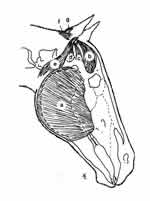 |
| Click here to view a larger image (42 Kb) |
Exploring the Anatomy of the Temporomandibular Joint
The TMJ Mechanism of the horse is more complex than that of a human. This complexity is due to three main reasons. The first reason is that horses have movable ears. The second reason is that in horses, the hyoid bone articulates with the temporal bone. The third reason is that horses have erupting teeth throughout their lifetime.
The TMJ Mechanism is more than just bone matter. Muscles, ligaments, and tendons surround the synovial joints (one on each side of the head) formed between the condyles of the mandible and the temporal bone. These bones connect in a capsulated joint where an articular disc allows for a gliding movement of the condyle. The mandible articulates and communicates with the temporal bone in this very strong, tight synovial joint capsule. It is supported and reinforced by ligaments and is then supported by the muscles that coordinate movement of the mandible for proper mastication. Any tightness in the muscles, tendons or ligaments of the TMJ Mechanism will inhibit the function of the TMJ. In the event of these muscles tightening and shortening, the body then negatively compensates for the imbalance. The proper function of the TMJ Mechanism therefore plays an important role in the whole function of the horse, including leads, gaits, balance and equilibrium.
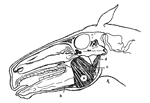 |
| Click here to view a larger image (32 Kb) |
Bones of the TMJ Mechanism
There are important individual bones that make-up the TMJ Mechanism. The temporal bone is home to the auditory tube (eustachian tube), the place where balance and equilibrium are recorded by way of the vestibulocochlear nerve. Any tightness of the muscles of the TMJ Mechanism can therefore adversely affect a horse’s balance and equilibrium. It is important to note the cranial nerve, also known as the trigeminal nerve branch, rests on the inside of the temporal bone. One of the three branches of the trigeminal nerve contains the motor nerve for the muscles for mastication/ chewing.
The next major bone is the mandible. At birth, this bone consists of left and right halves that join at a cartilaginous center (like that of the pubic bone of the pelvis). Between two to three months of age, these two halves fuse together and form one complete bone. The mandible is considered to be one of the largest pattern-setters in the body. A pattern-setter is the term used to describe a body part or condition that sets up a pattern of habitual compensatory movement of other parts of the body. For example, when the mandible’s function is compromised in some way, it creates areas of negative compensation throughout the body. Any tightness in the TMJ mechanism affects other areas in the body, especially pelvic movement.
It is also important to mention the contact the lower jaw or mandible has with the 'upper jaw' or maxilla, through the teeth.
The final bone of importance is the hyoid bone, which is located in the throatlatch area. The hyoid connects to the larynx, pharynx and tongue and articulates with the temporal bone.
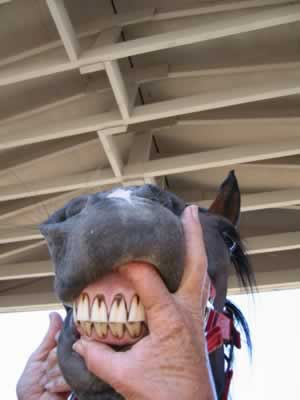 |
| Proper alignment of the lower jaw and upper jaw, however notice the slight retrusion in the lower jaw. |
Major Muscles of the TMJ Mechanism
There are several major muscles responsible for the movement of the jaw and its proper function. The largest of these muscles is the masseter muscle. The function of the masseter muscle is to bring the upper jaw and lower jaw together. The masseter muscle attaches to the ridge of the maxilla and zygoma bone, which is directly under the orbit of the eye. It then attaches to the angle of the body of the mandible. The masseter is the large muscle that can be seen moving while a horse is chewing. (Figures 2 and 3 show the primary muscles the horse uses in chewing/ mastication.)
The next major muscle is the temporalis muscle. The function of this muscle is to close the mandible. The temporalis muscle works in conjunction with the masseter muscle. The origin of this muscle is the temporal bone and it attaches to the coronoid process of the mandible.
Lastly, are the pterygoid muscles. The function of the pterygoid muscles is to pull the mandible side to side, as in chewing. These muscles attach from the sphenoid bone, the central bone of the cranium, and insert onto the medial (inside) portion of the mandible.
There are also twenty-one muscles in each ear that aid in the movement of the ears. These muscles add to the complexity of the TMJ Mechanism. When any of the above muscles become shortened or tightened, it will negatively affect the proper function of the mandible and cause improper wearing of the teeth. A crucial concept to remember is that the TMJ does not function independently, but is intricately interconnected with the rest of the body - through the Stomatognathic System.
The Stomatognathic System and Guzay’s Theorem
The TMJ Mechanism connects to the body through an intricate system known as the Stomatognathic System. The Stomatognathic System consists of the parts of the head, the neck, and the upper thorax. This system is concerned with muscular, osseous (bone), ligamentous, fascial and nervous system control of biting, chewing and swallowing, and is comprised of twenty-seven bones, one of those bones being the mandible. Thus, each part must be addressed to truly treat any TMD condition. However, another joint area that is connected to and highly affected by the condition of the TMJ is that of the atlantoaxial joint. This is the area where the atlas, the first cervical vertebra (C1), articulates with the axis, the second cervical vertebra (C2).
 |
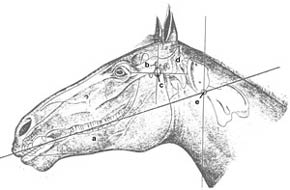 |
|
| Side view of a retrusion of the mandible, TMD - the masseter muscle here shows slight atrophy and other muscles have started to compensate for this. | Guzay's Theorem. a: mandible, b: temporal bone, c: condyle, d: occiput, e: atlantoaxial joint |
|
|
Guzay's Theorem was adapted by Maureen Rogers, who was the first to apply this to horses, which is why it is now referred to as Roger's Theorem. | ||
Guzay’s Theorem states that the atlantoaxial axis of rotation acts as the primary joint for mastication/ chewing. Although the TMJ, in the immediate structural and physiological sense, seems to be the axis of rotation of the mandible, a deeper look shows that the TMJ acts as the secondary joint of mastication. These two joints, the TMJ and the atlantoaxial joint, interact in every moment to provide healthy function for the mandible (see diagram). To properly address any TMD condition, it must be treated holistically, attending to the whole Stomatognathic System. Treatment that does not address all parts will not rectify a dysfunctional component of the Stomatognathic System; treating a singular area will only achieve a rearrangement of symptoms. This is the reason that, although it is a vital component, dental work alone will not resolve most TMD conditions.
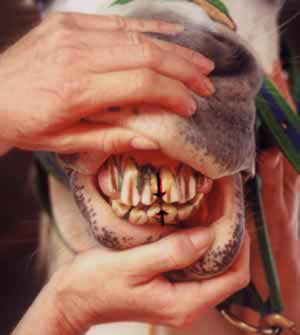 |
| TMD comes in many forms. Note the tongue between the upper and lower teeth to take pressure off of the TMJ. Proper dental work is highly necessary, as is soft tissue work, for this horse. |
How Does TMD Start?
In some cases TMD patterns can start as early as birth. Getting a clear idea of when TMD patterns may have started is sometimes impossible. However, the following are some of the influences that start to affect the function of the TMJ Mechanism:
- An early injury in life possibly stemming all the way back to birth
- The use of bits in the mouth
- The amount of tension applied to the bit by the rider
- Dental work - depending on how it is performed
- The use of the speculum during dental work (though it is usually a must)
- The use of sedatives during dental work (often necessary) or otherwise - although the horse is 'quieted', the muscles are still active and functional under sedation, tightening the muscles of the TMJ
- Lack of pasture grazing
- Feeding from hayracks of any sort
- An injury to the head, poll or pelvis; "pulling back"
Any of the above may be contributors to a TMD condition.
Physical Signs of Discomfort of the TMJ Mechanism
There are several questions you need to address to assess if your horse has physical signs of discomfort of the TMJ mechanism. They consist of the following:
- Does your horse’s tongue rest between his upper teeth and lower teeth?
- Does your horse drop large amounts of food?
- Does he pass whole food in his manure?
- Can you hear a popping and/or clicking while your horse chews?
- Does your horse have difficulty flexing at the poll?
- Does your horse chew more on one side compared to the other, or always in the same direction?
- How does your horse hold his neck and move in leads?
- How are your horses’ teeth wearing? (Accessories as simple as nosebands can and will affect the TMJ Mechanism and the body.)
Next, get physical and gently palpate the muscles on and around the mandible. Notice the quality of the muscles. Do they feel soft or do they feel like a rock? Does the muscle invite you in or push you out?
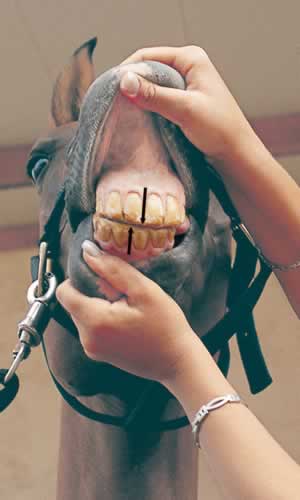 |
| The alignment of the TMJ is off by one full incisor - a sign of TMD. Dental work and soft tissue work are needed. |
Preventive Practices
Grazing is one of the most important preventive practices. The horse is a grazing animal and depends on the healthy function of his jaw to survive. Grazing allows: the mandible to come down and forward in the joint capsule, the atlantoaxial joint to open, and the mandible to move up and down, side to side forward and back with out any inhibition. It also allows the teeth of the maxilla and mandible to occlude properly. Normally, a horse grazes about sixteen hours a day. For horses who do not get turned out to graze on pasture, such as many performance horses who are kept in stalls, it’s best to have hay available throughout the day - on the ground, not in a rack. It is important that, when a horse eats, his head is down and extended, just like that of a horse grazing. Grazing also allows for horses to relax, and allows for the necessary wear of the incisors, which doesn't happen when eating hay.
Besides maximizing grazing, preventive practices include maximizing horsemanship to minimize restraints. Maximize nutrition and use sensible feeding and management practices. Maximize locomotion with continual turnout and regular, sensible exercise. Include gentle, hands-on bodywork in the horse-care program.
Treatment of TMD
It is beneficial to first address and correct any existing 'mechanical' contributors such as hoof trimming, saddle fit, bit use, feeding practices, and dental issues. Without addressing these issues first, the results of bodywork will be limited. In addition, it is absolutely necessary to address the soft tissue and help bring balance back to the body - through massage, TTouch, acupuncture, Feldenkrais, myofascial work, and/or especially craniosacral work, which specifically address the Stomatognathic system. Another consideration may be to change the horse’s training regimen. There is no simple answer or single approach when dealing with horses that have progressive cases of TMD, or when dealing with any problems. Remember to always consult with your veterinarian, equine dentist, and other qualified professionals who understand your horse, the TMJ, and TMD conditions.
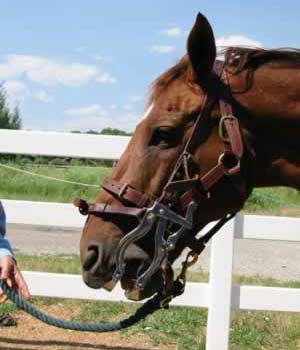 |
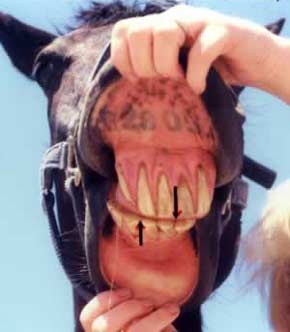 |
|
| The use of a speculum applies some pressure on the atlantooccipital area. The muscles of the TMJ are also affected. It is important to have it as loose as possible during dental treatment. | A severe case of TMD; once again, dental work and soft tissue work are necessary here. |
Summary
When TMD exists, the reality is that dental work alone will not fix this problem. The soft tissue needs to be treated, along with having dental work, to achieve substantial improvement and complete recovery. Therefore, the treatment of TMD is a bit more complicated than one might think. Because of the complex connection the mandible has with the rest of the body, "filing down" a horse’s teeth will not “fix” the problem. [See NHM Volume 4, Issue 5, Equissentials.] In some cases, filing down the teeth will worsen the TMJ condition that may already exist. In many cases, it is the soft tissue that has started an improper wear of the teeth. The soft tissue must be addressed and treated, as well as the energy patterns holding the TMJ in a “dysfunctional pattern”. Depending on the length of time the condition has existed, it may have worked its way through the entire body, causing the horse to compensate in his work, thus unbalancing him and inhibiting his performance and athletic abilities. Over time, if the soft tissue is not treated, the same patterns will continue and worsen, and bone structure and shape can be affected. Proper dental work must be performed in combination with soft tissue work; these cannot be individual of each other.
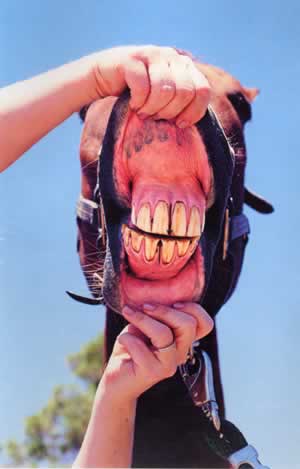 |
| Once again a case of TMD clearly shown. |
About the author
Maureen Rogers is a consultant who specializes in Craniosacral work with horses and other animals. She is the founder of Equine CranioSacral Workshops© based out of Southern California. She has studied Craniosacral work extensively and her private practice includes performance horses, dressage horses, racehorses, cutting horses, hunter-jumpers, humans and small animals.
Thank you to both Laura Zuckerman and Linda O. Drake for your help in putting this article together.
© 2002 Equine Craniosacral Workshops, Maureen Rogers
For more information regarding Equine Craniosacral Work, contact Maureen Rogers at Equine Craniosacral Workshops,
by phone at 831-642-2210,
or
| Home | Benefits | What's New | Press Releases | Biography | Links | Contact Us | |||
| Articles | Workshops | Workshop Schedule | Workshop Registration | |||
| Headshaking | Equine Assessment | Equine Dentistry | ECS Practitioners | |||
| ECS 1 | ECS 2 | ECS 3 | ECS 4 | ECS 5 | ECS Review | CCS 1 | CCS 2 | |||
Copyright © 2000 -
Maureen Rogers |
All photographs on this website were shot for the exclusive use of the Equine CranioSacral Workshops. |
||


